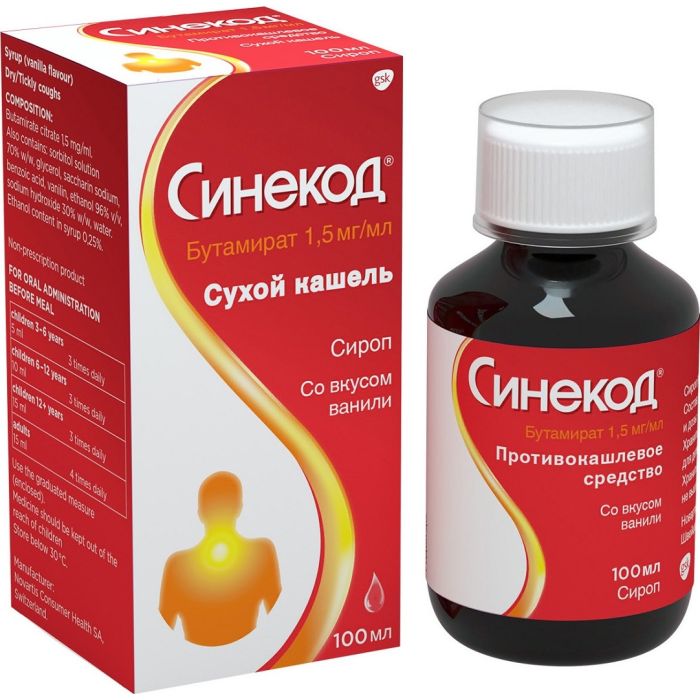Sinecode syrup bottle 100ml
Category
Cough
Scope of the medicinal product
Respiratory system
Release form
Syrup
Manufacturer country
Switzerland
Package quantity, pcs
one
Release form, composition and packaging
?
Syrup (vanilla) in the form of a colorless transparent liquid with a vanilla smell.
1 ml
butamirate citrate 1.5 mg
sorbitol solution 70% m / m - 40.5% m / v, glycerol - 29% m / v, sodium saccharinate - 0.06% m / v, benzoic acid - 1.115% m / v, vanillin - 0.06% m / vol., ethanol 96% vol./about.
- 0.25% m / v., Sodium hydroxide 30% m / m - 0.031% m / v., Water - up to 100 ml.
100 ml - dark glass bottles (1) complete with a measuring cap - cardboard packs.
200 ml - dark glass bottles (1) complete with a measuring cap - cardboard packs.
pharmachologic effect
Antitussive drug of central action, does not belong to opium alkaloids, either chemically or pharmacologically.
Does not form addiction or addiction.
Suppresses cough, having a direct effect on the cough center.
It has a bronchodilating effect.
Helps to facilitate breathing, improving spirometry (reduces airway resistance) and blood oxygenation.
Pharmacokinetics
Absorption Based on the available data, it is assumed that the ester of butamirate is rapidly and completely absorbed and hydrolyzed in plasma to 2-phenylbutyric acid and diethylaminoethoxyethanol. The effect of food on absorption has not been studied. The change in the concentration of 2-phenylbutyric acid and diethylaminoethoxyethanol occurs in proportion to the dose taken in the range of 22.5-90 mg. Butamirate is rapidly and completely absorbed when taken orally, measured concentrations are found in the blood 5-10 minutes after ingestion in doses of 22.5 mg, 45 mg, 67.5 mg and 90 mg. Cmax in blood plasma is achieved within 1 hour when taken in all 4 doses, the average is 16.1 ng / ml when taken orally at a dose of 90 mg. Average plasma concentrations of 2-phenylbutyric acid are reached within 1.5 hours Cmax was observed at a dose of 90 mg (3052 ng / ml) average plasma concentrations of dithylaminoethoxyethanol are reached within 0.67 hours Cmax is observed after taking at a dose of 90 mg (160 ng / ml). Distribution Butamirate has a large Vd in the range of 81-112 L (corrected for body weight in kg), as well as a high degree of binding to plasma proteins. 2-phenylbutyric acid has a high degree of binding to plasma proteins at all doses (22.5-90 mg) and averages 89.3-91.6%. Also, the ability of diethylaminoethoxyethanol to bind to plasma proteins is found, the average values ��vary in the range of 28.8-45.7%. It is not known whether butamirate crosses the placental barrier, whether it is excreted in breast milk. Metabolism Hydrolysis of butamirate, which results in the formation of 2-phenylbutyric acid and diethylaminoethoxyethanol, which have antitussive action, occurs very quickly.2-phenylbutyric acid undergoes further partial metabolism by hydroxylation in the para-position. Excretion Excretion of the three metabolites occurs mainly by the kidneys after conjugation in the liver, acidic metabolites bind largely to glucuronic acid. Conjugates of 2-phenylbutyric acid are detected in urine at significantly higher concentrations than in blood plasma. Butamirate is detected in urine within 48 hours, butamirate excreted in urine during the 96-hour sampling period accounts for about 0.02, 0.02, 0.03 and 0.03% of the doses taken 22.5 mg, 45 mg, 67.5 mg and 90 mg, respectively ... As a percentage, butamirate is excreted in the urine in greater amounts and in the form of diethylaminoethoxyethanol than unchanged butamirate or unconjugated 2-phenylbutyric acid.The measured T1 / 2 of 2-phenylbutyric acid, butamirate and diethylaminoethoxyethanol is 23.26-24.42, 1.48-1.93 and 2.72-2.90 hours, respectively.
Indications for use
- symptomatic treatment of dry cough of various etiology: suppression of cough in the pre- and postoperative period, during surgical interventions, bronchoscopy, with whooping cough.
Contraindications for use
- increased
Name ENG
SINECOD
Clinical and pharmacological group
Antitussive drug
ATX code
Butamirate
Dosage
1.5mg / ml x 100ml
Structure
100 ml of syrup contains: Active ingredient: butamirate citrate - 0.150 (1.5 mg / ml).
Excipients: sorbitol solution 70% m / m 40.50, glycerol 29.00.
sodium saccharinate 0.06, benzoic acid 0.115, vanillin 0.06, ethanol 96% v / v.
0.25, sodium hydroxide 30% m / m 0.031, water up to 100 ml.
Indications
dry cough of various etiologies (including whooping cough)
suppression of cough in the pre- and postoperative period during surgery and bronchoscopy
Storage conditions and periods
At a temperature not higher than 30 degrees.
Expiration date: 3 years
INN / Active ingredient
Butamirat
Contraindications
children up to 2 months (for drops) children up to 3 years (for syrup) hypersensitivity to the components of the drug.
Specifications
Category
Cough
Scope of the medicinal product
Respiratory system
Release form
Syrup
Manufacturer country
Switzerland
Package quantity, pcs
one
Scope of application
Virology
Minimum age from
3 years old
Way of introduction
Through the mouth
Vacation conditions
Without recipe
Volume, ml.
100 ml
Brand name
Sinekod
Components
measuring cap
The amount of the dosage form in the primary package
100 ml
Primary packaging type
Dark glass bottle
Type of consumer packaging
Pack of cardboard
Pharmaco-therapeutic group
Central antitussive agent
Anatomical and therapeutic characteristics
R05DB13 Butamirate
Dosage form
Syrup [vanilla]
The target audience
Children
Expiration date in days
1095
Dosage (volume) of the substance in the preparation
butamirate citrate 1.5 mg
Package weight, g
150
Mode of application
:
The drug is taken orally, before meals. < br> < br> Children from 3 to 6 years old: 5 ml 3 times a day. < br> Children from 6 to 12 years old: 10 ml 3 times a day. < br> Children 12 years and older: 15 ml 3 times a day. < br> Adults: 15 ml 4 times a day. < br> Use the measuring cap (included).
The measuring cap should be washed and dried after each use.
If the cough persists for more than 7 days, you should see a doctor.
Information on technical characteristics, delivery set, country of manufacture

